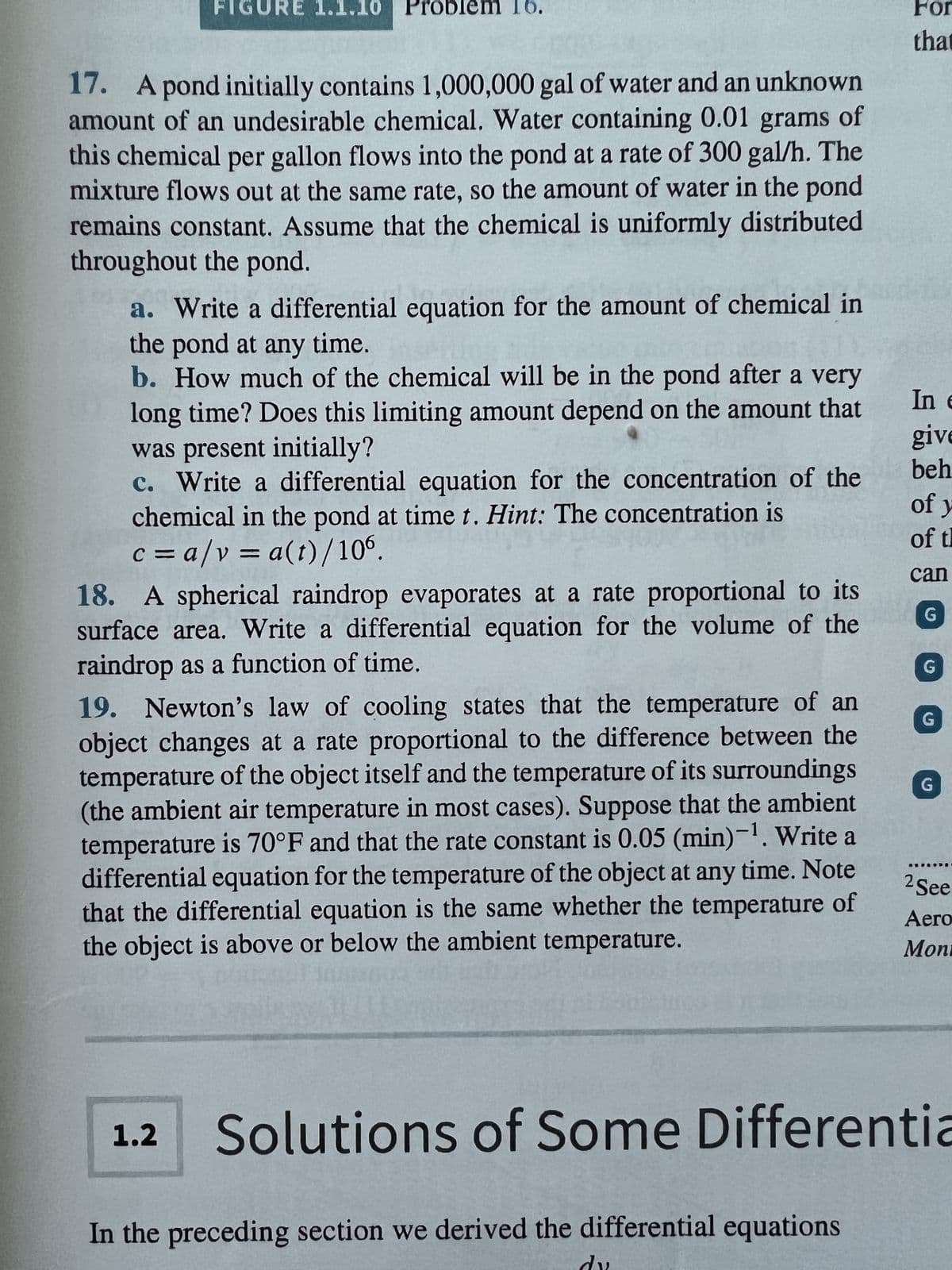17. A pond initially contains 1,000,000 gal of water and an unknown amount of an undesirable chemical. Water containing 0.01 grams of this chemical per gallon flows into the pond at a rate of 300 gal/h. The mixture flows out at the same rate, so the amount of water in the pond remains constant. Assume that the chemical is uniformly distributed throughout the pond. a. Write a differential equation for the amount of chemical in the pond at any time. b. How much of the chemical will be in the pond after a very long time? Does this limiting amount depend on the amount that was present initially? c. Write a differential equation for the concentration of the chemical in the pond at time t. Hint: The concentration is c = a/v = a(t)/ 106.
17. A pond initially contains 1,000,000 gal of water and an unknown amount of an undesirable chemical. Water containing 0.01 grams of this chemical per gallon flows into the pond at a rate of 300 gal/h. The mixture flows out at the same rate, so the amount of water in the pond remains constant. Assume that the chemical is uniformly distributed throughout the pond. a. Write a differential equation for the amount of chemical in the pond at any time. b. How much of the chemical will be in the pond after a very long time? Does this limiting amount depend on the amount that was present initially? c. Write a differential equation for the concentration of the chemical in the pond at time t. Hint: The concentration is c = a/v = a(t)/ 106.
Operations Research : Applications and Algorithms
4th Edition
ISBN:9780534380588
Author:Wayne L. Winston
Publisher:Wayne L. Winston
Chapter17: Markov Chains
Section17.2: What Is A Markov Chain?
Problem 4P
Related questions
Question
17

Transcribed Image Text:RE 1.1.10 Problem 10
17. A pond initially contains 1,000,000 gal of water and an unknown
amount of an undesirable chemical. Water containing 0.01 grams of
this chemical per gallon flows into the pond at a rate of 300 gal/h. The
mixture flows out at the same rate, so the amount of water in the pond
remains constant. Assume that the chemical is uniformly distributed
throughout the pond.
a. Write a differential equation for the amount of chemical in
the pond at any time.
b. How much of the chemical will be in the pond after a very
long time? Does this limiting amount depend on the amount that
was present initially?
c. Write a differential equation for the concentration of the
chemical in the pond at time t. Hint: The concentration is
c = a/v = a(t)/106.
18. A spherical raindrop evaporates at a rate proportional to its
surface area. Write a differential equation for the volume of the
raindrop as a function of time.
19. Newton's law of cooling states that the temperature of an
object changes at a rate proportional to the difference between the
temperature of the object itself and the temperature of its surroundings
(the ambient air temperature in most cases). Suppose that the ambient
temperature is 70°F and that the rate constant is 0.05 (min)-¹. Write a
differential equation for the temperature of the object at any time. Note
that the differential equation is the same whether the temperature of
the object is above or below the ambient temperature.
1.2
For
that
In the preceding section we derived the differential equations
In e
give
beh
of y
of th
can
G
G
G
G
D
2 See
Aero
Moni
Solutions of Some Differentia
Expert Solution
This question has been solved!
Explore an expertly crafted, step-by-step solution for a thorough understanding of key concepts.
Step by step
Solved in 3 steps with 14 images

Knowledge Booster
Learn more about
Need a deep-dive on the concept behind this application? Look no further. Learn more about this topic, computer-science and related others by exploring similar questions and additional content below.Recommended textbooks for you

Operations Research : Applications and Algorithms
Computer Science
ISBN:
9780534380588
Author:
Wayne L. Winston
Publisher:
Brooks Cole

Operations Research : Applications and Algorithms
Computer Science
ISBN:
9780534380588
Author:
Wayne L. Winston
Publisher:
Brooks Cole